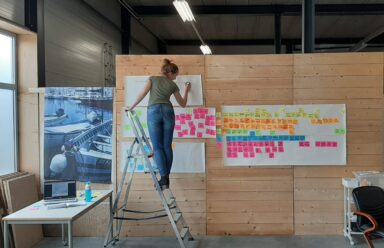
A new view on customer experience: 3 perspectives
This blogpost has been published on Frankwatching by Mark Geljon.
The struggle is shifting. Ten years ago, it was good enough to optimize your website or create a strong value proposition. In today’s times you need to do a lot more. It is crucial to put the customer in the center of the (design of the) total company and design towards his ambitions and needs. This activity cannot be done in isolation, you need to address it from a more holistic view. We call this Customer Experience.
Customer Experience (CX) is the overall emotional and rational human connection of a customer with an organization and its direct and indirect offerings, interactions, and manifestation in the broadest sense.
It is the sum of all the digital and physical brand experience, product experience, service experience, including all experiences with channels, touchpoints, platforms, and communities. CX Design is the art and craft of designing organizations and their touchpoints in an optimal way. Although these definitions may clarify the conceptual and academic definitions, we feel we need to sketch its importance through three perspectives.
Perspective 1. Story
For people it is essential to connect to organizations, brands or products based on a ‘Why’. If we understand the motives and visions of an organization, we can decide if we trust them and can connect to them. If we do, we have a solid basis for building a connection that is stronger than every other aspect of business. We even are willing to (temporarily) pay more, have struggles or wait longer. Think of Kickstarter campaigns that take too long to deliver. Brands like Apple that charge ridiculous amounts of money for simple products, but since we feel connected to the story of Apple (design driven products) we are buying the latest iPhone, just because we want to feel connected to the story. Driving an old SAAB as a daily, despite that it breaks down every month. We feel part of the story of this beautiful brand that no longer exists. We are willing to take all this, as long as we have a clear sense of the story of the product or service and we see ourselves playing a role in that story for example as an investor (Kickstarter), a brand evangelist (Apple) or as a treasurer of a brand (e.g. Saab).
There is a limit to all this though. We can only have a limited amount of struggle or set back, or we can only pay a limited amount extra. We need a payoff. An excellent experience, a community that offers us strong connection or the joy of owning something long before others do. We want great value!
Perspective 2. Value
The story can make us connect but it is its value that makes the connection sustainable. Both rational value such as product/service value or cost effectiveness as emotional (perceived) value such as boost in branding, trust, convenience, etc. These values should be based on strong propositions and reflected in a strong positioning. This is the traditional view of marketing: ensuring that the product/service offers value to the customer, establishing a good price and building a strong brand to support it. But it is also the traditional view of operational excellence: first time right, seamless operations and LEAN organizations. Ensuring that the service is delivered in a smooth, comfortable way.
But in today’s world offering great value is not enough. We all want seamless, great experiences. We want things instantly, have clarity at all times and demand one–click transactions. We want optimal interactions.
Perspective 3. Interactions
The Customer Experience is often defined as “the sum of how the interactions with a brand make you feel”. So, at the end of the day it is based on the digital and physical interactions with an organization. There are very few brands that have the scale ánd are capable of ‘designing‘ the customer experience across all relevant touchpoints; both physical and digital. The ones who do are extremely successful, think of Tesla, Starbucks, Coolblue.
Good CX requires you to tick all the boxes
How do the perspectives relate? There is no strict truth there. You can approach it from different angles. Often there is one perspective as starting point. An NGO for example starts with the WHY and drives the experience from that. An excellent product would often start from the VALUE and an excellent web-service from a specific touchpoint.
There is one big catch though. For a good customer experience, you need to tick all the boxes. Missing one of the elements means that the total experience is not optimal. So, in the end, it all comes down to excellent execution and implementation of CX driven improvements, how big or how small they are. A thorough approach to Customer Experience design is key for this. Essential is to make sure CX is the focus for the whole organization and is deployed as such. We call this customer dedication.
The impact of great CX
Where the value of a specific touchpoint can hardly ever be quantified in terms of bottom line impact for a company, improvements of the total customer experience can be quantified more easily. A lot has been written about this, and the common denominator in terms of CX benefit areas are:
- Direct increase in sales (less commercial waste due to more completed buying journeys)
- Increase in customer lifetime value
- Increase in customer retention / repeat buy
- the focus on consistency results in increased revenue, lower costs and increased customer satisfaction
A new look at customer experience through the 3 perspectives
We are at the forefront of big changes in the fields of brand experiences. With every excellent Customer Experience, the bar is raised for all the other companies. But the step ups needed are hard to make, there is no short-cut. And even companies that are embracing CX in their strategies find themselves plateauing on a suboptimal level. Capabilities across the whole company need to be upgraded ánd a CX strategy needs to drive this. Smart choices, great optimizations all within budget constraints and extreme pressure on time to market.
The three perspectives help to realize a great CX. The story perspective guides you to give a foundation that is consistent with the organizations purpose and brand. The value perspective helps you to ensure a good value proposition and fulfillment. The interactions perspective glues it all together and makes sure that you design for consistency and value.
 Mark Geljon
Mark Geljon 

